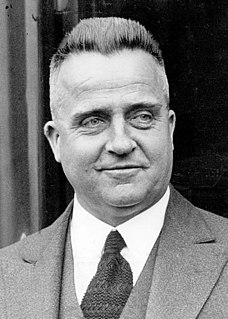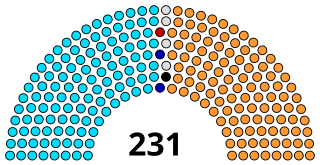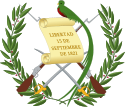The Quebec general election of 1936 was held on August 17, 1936 to elect members of the Legislative Assembly of the Province of Quebec, Canada. The Union Nationale, led by Maurice Duplessis, defeated the incumbent Quebec Liberal Party, led by Adélard Godbout.
The Quebec general election of 1935 was held on November 25, 1935 to elect members of the Legislative Assembly of the Province of Quebec, Canada. The incumbent Quebec Liberal Party, led by Louis-Alexandre Taschereau was re-elected, defeating the Action libérale nationale, led by Paul Gouin, and the Quebec Conservative Party, led by Maurice Duplessis.

The West Bengal Legislative Assembly is the unicameral legislature of the Indian state of West Bengal. It is Located in the B. B. D. Bagh area of Kolkata (Calcutta)-the Capital of the state. Members of the Legislative assembly are directly elected by the people. The legislative assembly comprises 295 Members of Legislative Assembly, which include 294 members directly elected from single-seat constituencies and one nominated from the Anglo-Indian community. Its term is five years, unless sooner dissolved.
This is a list of members of the Western Australian Legislative Assembly between the 1933 election and the 1936 election, together known as the 15th Parliament.

Uttar Pradesh Legislative Assembly is the lower house of the bicameral legislature of the Indian state of Uttar Pradesh. It has a total of 403 members excluding one Anglo-Indian member who is nominated by the Governor. Till 1967, it had a strength of 431 members including one nominated Anglo-Indian member. According to the recommendation of the Delimitation Commission, which is appointed after every Census, it was revised to 426. After reorganization of the State on 9 November 2000, the strength of the Legislative Assembly has become 404 including one nominated member to represent the Anglo-Indian community. The Term of the Vidhan Sabha is five years unless dissolved earlier. The election is held on the principle of "one adult one vote".
The Wisconsin Progressive Party (1934–1946) was a political party that briefly held a dominant role in Wisconsin politics.
This is a list of members of the 27th Legislative Assembly of Queensland from 1935 to 1938, as elected at the 1935 state election held on 11 May 1935.

The Tamil Nadu Legislative Assembly alone has powers to legislate laws covering state subjects in the Indian state of Tamil Nadu. It has a strength of 235 members of whom 234 are democratically elected using the First-past-the-post system. The remaining member is nominated as a representative of the Anglo-Indian community. The presiding officer of the Assembly is called the Speaker. The term of the Assembly is five years unless it is dissolved earlier.

Elections were held in the Australian state of Queensland on 11 May 1935 to elect the 62 members of the state's Legislative Assembly. The Labor government of Premier William Forgan Smith was seeking a second term after having defeated the Country and Progressive National Party in the 1932 election.

Elections were held in the Australian state of Queensland on 2 April 1938 to elect the 62 members of the state's Legislative Assembly. The Labor government of Premier William Forgan Smith was seeking a third term in office. During the previous term, the Country and United Australia parties had emerged from the united Country and Progressive National Party, which had represented conservative forces for over a decade.

The 1935 New South Wales state election was held on 11 May 1935. This election was for all of the 90 seats in the 31st New South Wales Legislative Assembly and was conducted in single member constituencies with compulsory preferential voting.

The Assam Legislative Assembly is the unicameral legislature of the Indian state of Assam. It is housed in Dispur, the capital of Assam, geographically situated in present Western Assam region. The Legislative Assembly comprises 126 Members of Legislative Assembly, directly elected from single-seat constituencies. Its term is five years, unless sooner dissolved.
The 1935 Philippine general election was the first general election of the Commonwealth of the Philippines. This was also the first direct election of the President of the Philippines and Vice President of the Philippines, positions created by the 1935 constitution. Furthermore, members of the National Assembly of the Philippines, that replaced the Philippine Legislature were elected.
The Elections for the Members of the National Assembly were held on September 16, 1935, pursuant to the Tydings–McDuffie Act which established the Commonwealth of the Philippines The leaders of the ruling Nacionalista Party, Manuel Quezon and Sergio Osmeña reconciled and became running mates in the presidential election but their supporters, the Democraticos and the Democrata Pro-Independencias respectively, effectively were two separate parties at the National Assembly elections.
Baroona was an electoral district of the Legislative Assembly in the Australian state of Queensland from 1935 to 1977.
The electoral district of Murilla was a Legislative Assembly electorate in the state of Queensland, Australia.

The Madhya Pradesh Vidhan Sabha or the Madhya Pradesh Legislative Assembly is the unicameral state legislature of Madhya Pradesh state in central India. The seat of the Vidhan Sabha is at Bhopal, the capital of the state. It is housed in the Vidhan Bhavan, an imposing building located at the centre of the Capital Complex in the Arera Hill locality of Bhopal city. The term of the Vidhan Sabha is five years, unless dissolved earlier. Presently, it comprises 230 members who are directly elected from single-seat constituencies and one nominated member.









